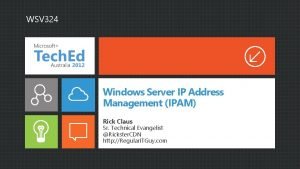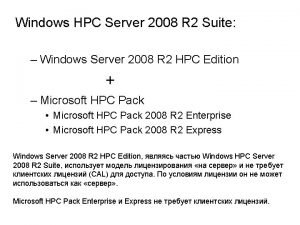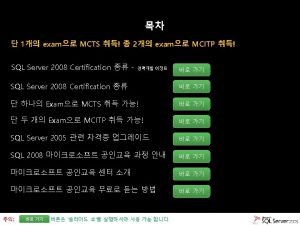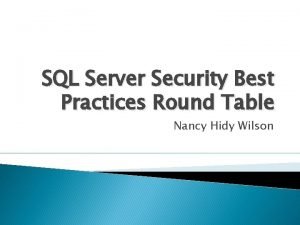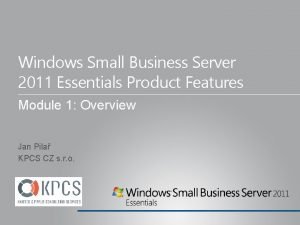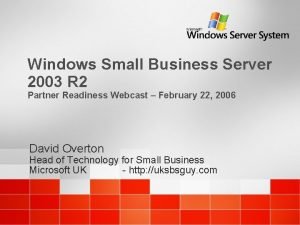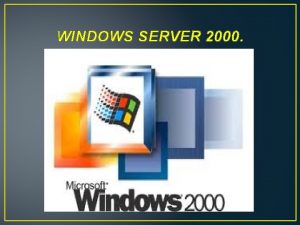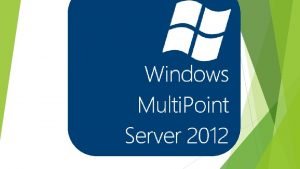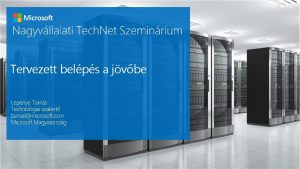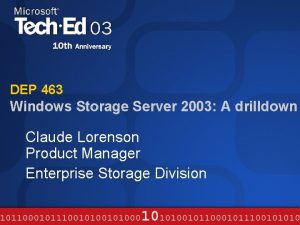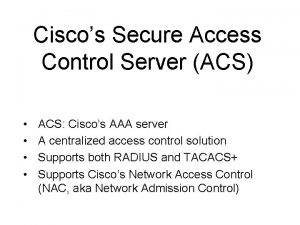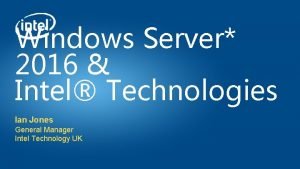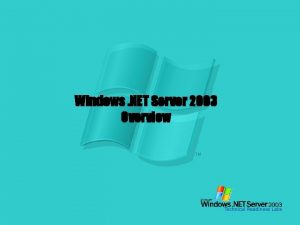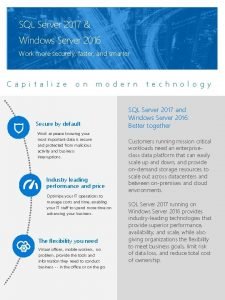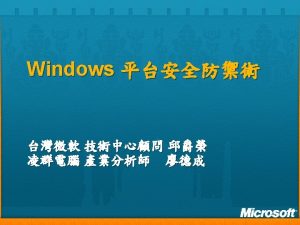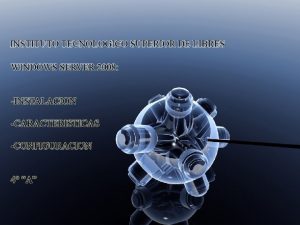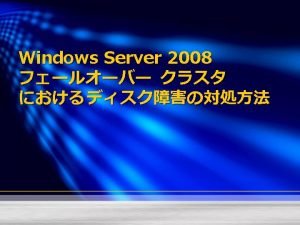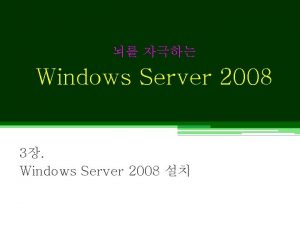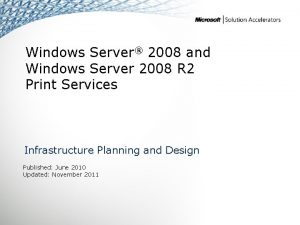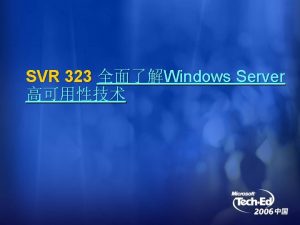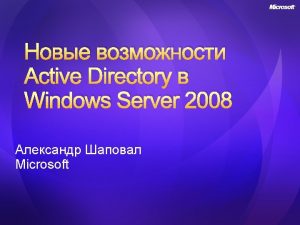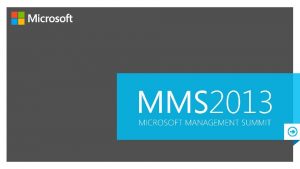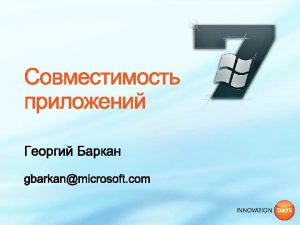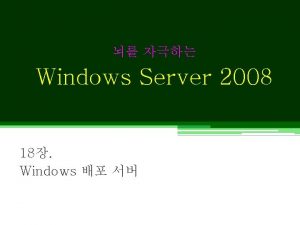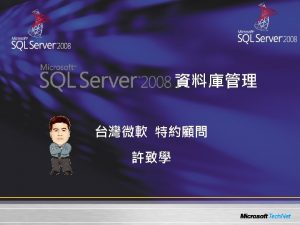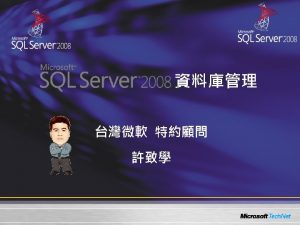Unit9 Windows 2008 server Introduction Windows server 2008




















- Slides: 20

Unit-9 Windows 2008 server

Introduction • Windows server 2008 is an operating system that enables core IT resources, such as file and print sharing, remote access and security. • It also provides a familiar windows user experience that helps you manage and safeguard business information. • The basic terminology related to windows server 2008 are as follow.

1) Window Domain – A windows domain is a form of a computer network in which all user accounts, computers and other security principles, are registered with a central database (Called directory services) located on one or more central computers known as domain controllers. – Authentication take place on domain controllers. 2) Configuration – Computers can connect to a domain via LAN, WAN or using VPN connection. – Smart card and digital certificate can be used to confirm identities and protect stored information

3) Domain Controllers – A domain controller is a windows server that manages all security related aspects between user and domain interactions, centralizing security and administrators. 4) Active Directory – Computers inside an Active Directory domain can be assigned into organizational units according to location, organization structure or other factor. 5) Work Groups – Work Groups is the other model for grouping computers running windows in a networking environment. – Work group does not have server and client, that uses peer-to-peer networking.

Difference editions of Windows server 2008 1. Windows server 2008 standard: – It is standard edition of server 2008 and is directed to the SMB sector, the server with operating system will often play a role of domain controller, File and print server, DHCP server and application server. – These servers do not require more memory. – The 32 bit version supports up to 4 GB RAM and up to 4 processor in SMP configuration – The 64 bit version supports 32 GB RAM and 4 processors SMP configuration.

2. Windows server 2008 Enterprise: – The enterprise edition will be intended for large companies running heavy application like SQL server or Exchange Server, these will be require , ore memory than standard edition. – The 32 bit version supports up to 64 Gb of RAM and up to 8 processors in SMP configurations – The 64 bit version supports up to 2 TB of RAM and up to 8 processors SMP configurations.

3. Windows server 2008 Datacenter: – Data center Intended only to large enterprise marker, the main difference from the enterprise is on the number of virtual machines that can be uses with single license is unlimited. – License of the Datacenter will be associated with a physical server. – These servers typically cost tens or even hundreds of thousand of dollars.

4. Windows Web 2008: – This edition is indicated only for servers that run IIS services, the Microsoft web server. – The 32 bit supports up to 4 GB of RAM and 4 processors in SMP configuration. – The 64 bit supports up to 32 GB of RAM and 4 processors in SMP configuration.

5. Windows Server 2008 Server Core: – Windows server 2008 have two types, Full and server core installation. – Full installation is where most functions are managed via the GUI (Graphical /user Interface) of CLI (Command Line Interface). – Server core run only in CLI.

Installation of windows server 2008 • Hardware and software configuration: – Processor : Minimum 1 GHz (x 84 processor) or 1. 4 GHZ (x 64 processor) – Recommended 2 GHz or faster. – Memory: Minimum 512 MB RAM – Recommended 2 GB RAM or grater – Maximum (32 -bit system) : 4 GB (Standard) or 64 Gb (Enterprise and Datacenter) – Maximum (64 -bit system) : 32 GB (Standard) or 2 TB (enterprise and Datacenter)

– Available Disk: Minimum 10 GB – Recommended 40 GB or Grater – Drive : DVD-ROM drive – Display and Peripherals: Super VGA (800 * 600( or higher resolution monitor – Keyboard – Mouse

Active Directory – Active directory consist of logical and physical components. – These components are used to develop directory structure for your organization. – Domain, Organization Units, Tree and forest are components that represent the logical structure. – Sites and domain controllers represents the physical structure.

Domain – It stores the fundamental objects of a network. – It is a central unit of a logical structure. The network objects such as the printers, documents, email addresses, databases and the users allows network community members to perform their respective task. – The domain includes all network objects and their information. – Network directory contains multiple domains. – It includes the network objects and stores information of the objects.

Organization Units – It allows you to administrator users and resources. – The OU also contains objects such as user accounts, groups, computers, printers applications, file sharing. – You can add OU to other OU to provide administrative control to it. This is called nesting. – Controls user and computer accounts.

Tree – Represents hierarchical arrangement of the windows server 2008 domains. – To create hierarchy you must identify the parent child relationship among domains. – Contains OUs, used to partition the directory data and controls – Example : University. com

Forest – It represent the hierarchical arrangement of the independent domain trees, – All domain in the forest share the same schema and global catalog. – Global analog is a central storage of the object information in the tree or forest residing on a domain controller. – Contains domains used to defines the scope of authority of the administrators.

Event Logging – Windows server includes two categories of event logs : Windows Logs and Applications and services Logs. – You can either the event viewer or command line tool to manage event logs (Wevtutil). 1. Windows Log: • • The windows logs category includes the logs that ware available on previous versions of the windows: the application, security and system logs. Windows log are intended to store event from applications and events that apply to the entire system.

2. Application Log: – An Application logs contains events logged by applications or programs. – For example: The database program might record a file error in the application log. 3. Security Log: – The security log contains events such as valid and invalid logon attempts, as events related to resource use, such as cresting opening or deleting objects.

4. Set up Log: – Set up logs contains events related to application setup. 5. System Log: – The system log contains events logged by windows system components. – For example : failure of a driver or other system to load during startup 6. Forwarded. Events Log: – The forward events log is used to store events collected from remote computers.

MMC (Microsoft Management Control) – MMC is a component in windows server 200 and above that provides system administrators and advanced users an interface for configuring and monitoring the system. – The Microsoft Management Console (MMC) is an application that provides a graphical-user interface (GUI) and a programming framework in which consoles (collections of administrative tools) can be created, saved, and opened. . MMC is considered to be a container for the actual operations, and is known as a "tools host. "
 Windows server ipam
Windows server ipam Windows server 2008
Windows server 2008 2008 2008
2008 2008 Sql server 2008 certification
Sql server 2008 certification Sql server management studio express 2005
Sql server management studio express 2005 Ms sql security best practices
Ms sql security best practices Microsoft windows small business server 2011 essentials
Microsoft windows small business server 2011 essentials Windows small business server 2011 end of life
Windows small business server 2011 end of life Sbs 2003 cals
Sbs 2003 cals Windows server 2000 caracteristicas
Windows server 2000 caracteristicas Windows multipoint server 2012
Windows multipoint server 2012 Windows server migration tools
Windows server migration tools Windows storage server 2003
Windows storage server 2003 Secure access acs
Secure access acs Windows codename longhorn
Windows codename longhorn Networking with windows server 2016
Networking with windows server 2016 Windows net server family
Windows net server family Sql server 2017 windows 7
Sql server 2017 windows 7 Nouveauté windows server 2016
Nouveauté windows server 2016 Windows server 2012 r2 essentials
Windows server 2012 r2 essentials Dlna server windows 10
Dlna server windows 10
